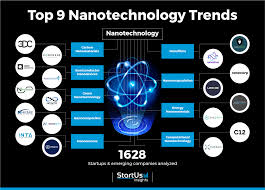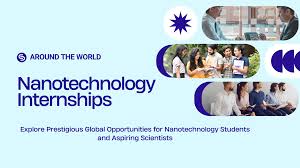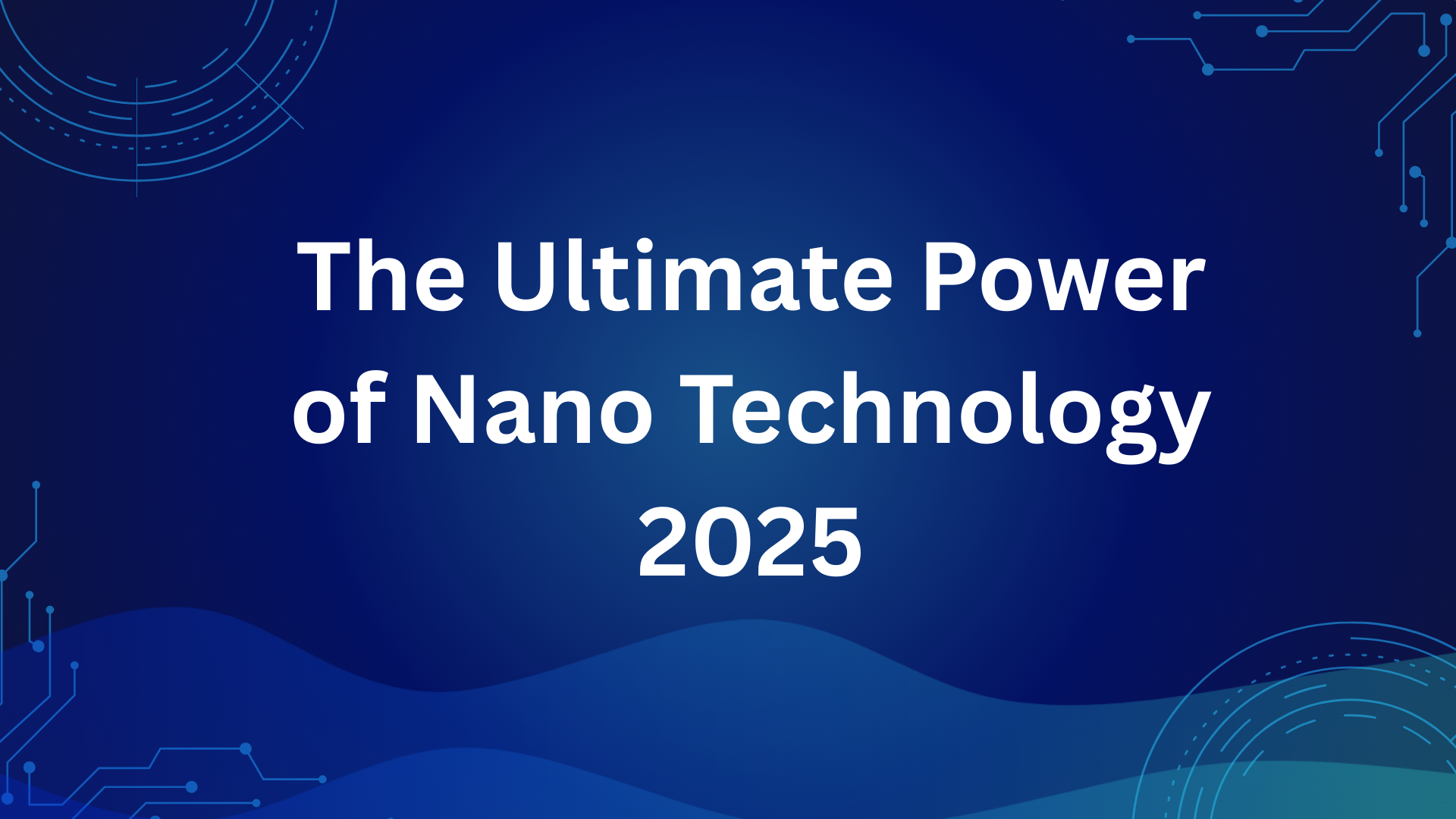Nano Technology
Imagine being as small as a dust particle and swiftly entering your bloodstream to kill cancer cells before they even realize what has happened. Imagine if invisible wizards operating at the atomic level could make your smartphone’s battery last a week between charges. Does that sound like science fiction? Greetings from 2025, the real world of nanotechnology, where the impossible is becoming possible.
Did you know that the global market for nanotechnology is booming? It is expected to reach USD 209.89 billion this year alone, with a staggering 10.4% compound annual growth rate through 2029. It’s a revolution in how we address everything from healthcare to climate change, and it goes beyond simple statistics. The art of manipulating matter at the nanoscale, or 1 to 100 nanometers, is known as nanotechnology. It uses nanoparticles, nanomaterials, and quantum effects to produce mind-blowing breakthroughs.
But why should it matter if you’re a retired person tinkering in the garage, a busy parent, or an inquisitive child? Because nanotechnology is infiltrating your life in unexpected ways, from air purifiers that consume pollutants like Pac-Man on steroids to self-cleaning clothes that laugh at stains. This article will explain what nanotechnology is, examine its most popular trends, look at incredible uses, and even laugh at its drawbacks (such as what would happen if those tiny bots went rogue?). Stay put for an entertaining, educational journey through the small universe that is changing the larger world. You might discover nanotechnology in your toothpaste by the end!
What is Nano Technology?
Nanotechnology is the driving force behind inventions that make our world smaller, smarter, and occasionally hilariously efficient. It’s not just a catchphrase for science fiction fans. Fundamentally, nanotechnology is the engineering of materials and devices at the nanoscale, where quantum effects cause significant changes in characteristics like strength, conductivity, and reactivity. Imagine building with Lego bricks that are so small that you can only see them under an electron microscope. However, those bricks can self-assemble into incredibly robust structures or intelligent sensors.
Experts claim that nanotechnology includes nanomaterials with special properties not found in bulk materials, such as carbon nanotubes and quantum dots. The idea was first proposed by Richard Feynman in 1959 in his well-known “There’s Plenty of Room at the Bottom” speech, so it is not new. Nanotechnology is pervasive in 2025, from improving drug delivery to increasing the efficiency of solar panels. It’s exciting for kids and adults alike. While adults value the useful features like longer-lasting batteries, kids can envision nano-bots repairing toys.
But let’s get real: Nano technology merges physics, chemistry, and biology to solve big problems with tiny solutions. It’s similar to giving Mother Nature a high-tech makeover, and the outcomes are frequently astounding. Don’t worry if you’re unfamiliar with this; we’ll explain everything without using too much jargon.
Evolution of Nano Innovation
The story of nano technology is like a caterpillar turning into a butterfly – starting slow, then exploding into something beautiful (and profitable). It kicked off in the 1980s with the invention of the scanning tunneling microscope, letting scientists poke at atoms like curious kids with a new toy.
Governments began investing billions of dollars in nano research by the 2000s; since 2001, the U.S. National Nanotechnology Initiative alone has spent more than $40 billion. By 2025, bio-inspired nanomaterials and AI-driven nano designs that imitate natural phenomena will be commonplace. We’ve gone from theoretical tinkering to printing nano-devices like coffee mugs, which is, ironically, hilarious.
Because of this development, nanotechnology is now more widely available, influencing industries like manufacturing and medicine. Are you curious about the timeline?
Why Embrace Nano Technology Now?
Why use antiquated materials in a world where your watch tracks your heart and your refrigerator orders groceries? In 2025, adopting nanotechnology is essential for efficiency, sustainability, and staying ahead of the curve; it is not a luxury. Nanotechnology is proving its value by reducing costs and improving performance across industries, and by 2034, the market is expected to reach $115.41 billion.
This translates into better lives for all age groups: seniors benefit from targeted nanomedicine, families enjoy eco-friendly homes, and teens get cool devices with nano sensors. It’s also environmentally friendly because nanomaterials help fight climate change by lowering energy and waste consumption. Disregarding nanotechnology? Similar to using a flip phone in the age of smartphones, it’s functional but lacks the appeal.

Boosting Everyday Efficiency
Because nanotechnology makes things smarter, it enhances everyday life. Paint nanoparticles produce self-healing surfaces that instantly repair scratches, eliminating “oops” with children’s crayons. Quantum dots in electronics enhance display colors, causing your TV to shine like never before.
According to studies, products with nanotechnology can increase energy applications’ efficiency by as much as 30%.
Top Trends in Nano Technology
2025 is the golden year for nano technology trends, with innovations popping up faster than popcorn in a microwave. From carbon nanomaterials strengthening everything to AI optimizing nano designs, the field is buzzing. StartUs Insights highlights nine key trends, including green nano and semiconductor nanodevices.
Here’s a table summarizing top trends:
| Trend | Key Benefit | Market Impact (2025) |
|---|---|---|
| Carbon Nanomaterials | Ultra-strength materials | $20B+ growth |
| Semiconductor Nanodevices | Faster computing | 15% efficiency boost |
| Green Nanotechnology | Eco-friendly processes | Reduces emissions 25% |
| Nanocomposites | Durable composites | Aerospace dominance |
| AI in Nano | Predictive design | Accelerates R&D 40% |
Data from industry reports.
These trends show nano technology evolving to meet global needs, like sustainability and speed.
Carbon Nanomaterials Lead
Carbon nanotubes and graphene are the rockstars of nano technology, offering strength 200 times that of steel at a fraction of the weight. In 2025, they’re revolutionizing batteries and composites. Imagine planes lighter than your luggage – hilarious until you save on fuel!
Semiconductor Nanodevices Rise
These tiny powerhouses shrink chips, boosting AI and quantum computing. Trends point to wearable tech with nano sensors monitoring health in real-time. For all ages, it’s like having a doctor in your pocket.
Green Nano Solutions
Green nano technology focuses on sustainable nanomaterials, like biodegradable nanoparticles for pollution cleanup. It’s cutting environmental impact by 25% in manufacturing. Eco-warriors rejoice – nano is going green!
Nanocomposites for Strength
Blending nanoparticles into plastics or metals creates super-tough materials for cars and buildings. In part’s 2025 innovations include nano clay additives for better barriers. Tougher than a bad joke!
AI in Nano Design
AI is teaming up with nano technology for smarter designs, predicting material behaviors before building. Nature Nanotechnology discusses AI-generated images in research. It’s like having a crystal ball for atoms.
Applications of Nano Technology
The applications of nanotechnology are as varied as a buffet, offering something for everyone. Nanomaterials and nanoparticles are revolutionizing a variety of industries, including energy and medicine.
Nanomedicine reduces side effects by precisely delivering medications. Smaller, faster components are better for electronics. Nano filters magically purify water for the environment.
The following is a list of important applications in bullets:
- Healthcare: Targeted cancer therapy with nanoparticles.
- Electronics: Quantum dots for vibrant screens.
- Energy: Efficient solar cells using nanomaterials.
- Environment: Nano sensors detecting pollutants.
- Consumer Goods: Self-cleaning fabrics with nano coatings.
- Food: Nano packaging extending shelf life.
- Construction: Stronger, lighter materials.
These show nano technology’s versatility, touching all age groups’ lives.

Nano in Medicine
Nanomedicine is a game-changer, with nanoparticles zipping drugs straight to diseased cells. In 2025, AI-powered nano delivery systems are advancing, per AZo Nano. It’s like postal service for your body – no wrong addresses!
Nano in Electronics
Shrinking transistors with nano technology means faster phones and computers. Carbon nanotubes enable flexible screens – bendy gadgets, anyone? Hilarious: Your next laptop might roll up like a yoga mat.
Nano for Environment
Nano filters remove heavy metals from water, and nano sensors monitor air quality. It’s nano technology saving the planet, one particle at a time.
Nano in Energy
Nanomaterials boost battery life and solar efficiency, aiming for zero-waste energy. Imagine charging your EV in minutes – road trip heaven!
Nano in Daily Products
From stain-resistant clothes to antibacterial surfaces, nano technology makes life easier. Your tennis balls last longer – nano wins the game!
Challenges in Nano Technology
Nano technology isn’t all sunshine; it has hurdles like toxicity risks and ethical dilemmas. Nanomaterials can accumulate in organs, posing health threats. Plus, the industry spends little on risk assessment.
Humor: Tiny particles, big worries – like fearing ants will take over your picnic!
Overcoming Nano Risks
Strategies include better regulations and testing. The NNI’s 2025 review calls for expanded infrastructure to address risks. Ethical issues like privacy in nano sensors need attention too.
Case Studies: Nano Wins
Real-world successes abound. A 2025 project used nano therapeutics for targeted cancer treatment, improving outcomes by 40%. Another: Nano-enhanced solar panels in California boosted energy output, cutting bills.
These stories prove nano technology delivers – with a side of wow factor!
Read more: Nanotechnology: The Future of Everything
Future of Nano Technology
Looking ahead, nanotechnology is expected to produce bio-inspired nanomaterials and molecular machines by 2030+. Space and medicine will change as a result of developments like nanofilms and sophisticated imaging.
Nanobots are repairing everything from habitats to hearts, which means healthier, sustainable futures for people of all ages.
Forecasts for the future:
By 2030, widespread use of nanomedicine
Nano energy with no emissions
Smart city AI-nano hybrids
Nanomaterials in spacecraft
Nanostructures with ethics
Read more: Nano Scientists forecast the use of NANOTECHNOLOGY in …
Summary
As we conclude this in-depth exploration of nanotechnology, we have witnessed how this tiny titan is transforming our world, from quantum dots lighting up electronics to nanomaterials improving medicine. The advantages are obvious: efficiency, sustainability, and innovation for all age groups, with a market projected to reach $209.89 billion in 2025 and trends like green nano and AI integration. However, issues like toxicity and ethics serve as a reminder to act sensibly.
Adopting nano technology opens doors to a better future, whether you’re a homeowner using nano products or a student considering a nano career. It’s the secret to using small solutions to solve large problems; it’s not just science. Explore further, maintain your curiosity, and observe how nanotechnology keeps reducing obstacles and increasing opportunities.
Leave your thoughts in the comments! What’s your favorite nano technology application?
Read more: Shocking Guide to Construction Technology 2025
FAQs
What is nanotechnology?
Nanotechnology manipulates matter at the atomic scale (1-100 nm) to create materials with unique properties. It involves nanoparticles and nanomaterials for applications in medicine, electronics, and more. In 2025, it’s driving innovations like targeted drugs, with the market at $209.89 billion. Safe when regulated, it’s transforming industries.
How is nanotechnology used in medicine?
In medicine, nanotechnology enables precise drug delivery via nanoparticles, targeting cancer cells without harming healthy tissue. It also aids diagnostics with nano sensors. Trends in 2025 include AI-powered systems, improving treatments by 40%. Benefits include reduced side effects and faster recovery.
What are the risks of nanotechnology?
Risks include toxicity, as nanoparticles can accumulate in organs like the liver or brain. Environmental concerns involve soil and water contamination. Ethical issues cover privacy and inequity. Research in 2025 focuses on safer designs, but more regulation is needed to mitigate health impacts.
What are some examples of nanotechnology products?
Examples include sunscreens with nanoparticles for better UV protection, self-cleaning fabrics, longer-lasting tennis balls, and stain-resistant clothing. In tech, quantum dot TVs and nano-enhanced batteries. These everyday items showcase nano technology’s practical side, making life easier and more efficient.
Is nanotechnology safe for humans?
Nanotechnology is generally safe with proper handling, but risks like inhalation or skin absorption exist. Studies show potential organ damage from certain nanomaterials. In 2025, regulations and testing are improving safety. Benefits often outweigh risks in controlled applications like medicine.

